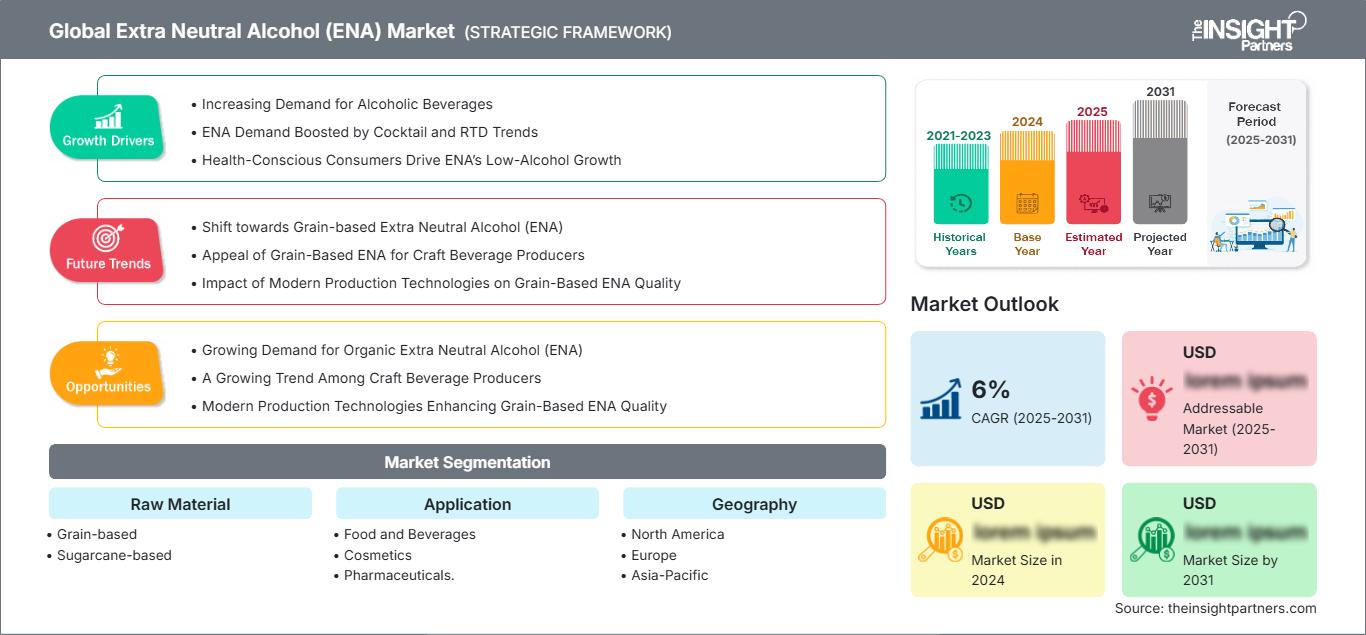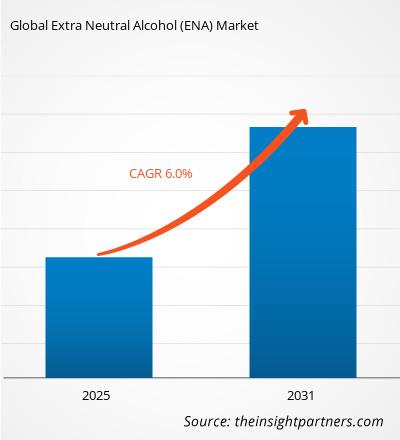Der Markt für extra neutralen Alkohol (ENA) wird voraussichtlich zwischen 2025 und 2031 eine durchschnittliche jährliche Wachstumsrate (CAGR) von 6 % verzeichnen, wobei die Marktgröße von XX Millionen US-Dollar im Jahr 2024 auf XX Millionen US-Dollar im Jahr 2031 anwachsen wird.
Der Bericht ist nach Rohstoffen segmentiert (auf Getreidebasis, auf Zuckerrohrbasis und andere). Basierend auf der Anwendung ist der Bericht in (Lebensmittel und Getränke, Kosmetika, Pharmazeutika und andere) segmentiert. Die globale Analyse ist weiter auf regionaler Ebene und nach wichtigen Ländern aufgeschlüsselt. Der Bericht bietet den Wert in USD für die obige Analyse und Segmente.
Zweck des Berichts
Der Bericht „Markt für extra neutralen Alkohol (ENA)“ von The Insight Partners zielt darauf ab, die gegenwärtige Situation und das zukünftige Wachstum sowie die wichtigsten treibenden Faktoren, Herausforderungen und Chancen zu beschreiben. Dies bietet verschiedenen Geschäftspartnern Einblicke, wie beispielsweise:
- Technologieanbieter/-hersteller: Um die sich entwickelnde Marktdynamik zu verstehen und die potenziellen Wachstumschancen zu kennen, damit sie fundierte strategische Entscheidungen treffen können.
- Investoren: Um eine umfassende Trendanalyse hinsichtlich der Marktwachstumsrate, der finanziellen Marktprognosen und der Chancen entlang der Wertschöpfungskette durchzuführen.
- Regulierungsbehörden: Um Richtlinien und Überwachungsaktivitäten auf dem Markt zu regulieren, mit dem Ziel, Missbrauch zu minimieren, das Vertrauen der Investoren zu wahren und die Integrität und Stabilität des Marktes aufrechtzuerhalten.
Marktsegmentierung für Extra Neutralalkohol (ENA) – Rohstoffe
- Getreidebasiert
- Zuckerrohrbasiert
Anwendung
- Lebensmittel und Getränke
- Kosmetik
- Pharmazeutika.
Sie erhalten kostenlos Anpassungen an jedem Bericht, einschließlich Teilen dieses Berichts oder einer Analyse auf Länderebene, eines Excel-Datenpakets sowie tolle Angebote und Rabatte für Start-ups und Universitäten.
Globaler Markt für extra neutralen Alkohol (ENA): Strategische Einblicke

-
Holen Sie sich die wichtigsten Markttrends aus diesem Bericht.Dieses KOSTENLOSE Beispiel umfasst Datenanalysen, die von Markttrends bis hin zu Schätzungen und Prognosen reichen.
Wachstumstreiber für extra neutralen Alkohol (ENA)
- Steigende Nachfrage nach alkoholischen Getränken: Die starke Nachfrage nach alkoholischen Getränken bleibt ein wichtiger Wachstumsfaktor für den Markt für extra neutralen Alkohol (ENA). ENA ist eine sehr reine Form von Ethanol und dient als Hauptzutat bei der Herstellung vieler Spirituosen und Liköre. Da die Verbraucher ihre Vorlieben für Premium- und Craft-Getränke immer weiter diversifizieren, steigt die Nachfrage nach hochwertigem ENA weiterhin stark an.
- ENA-Nachfrage durch Cocktail- und RTD-Trends angekurbelt: Das Wachstum von ENA wird zusätzlich durch die Beliebtheit von Cocktails und RTD-Produkten vorangetrieben. Diese Produkte benötigen eine hochwertige Alkoholbasis, um sie zu genießen und die Verbraucher zufriedenzustellen, was zu einer höheren Nachfrage führt. Die Nachfrage nach ENA wird weiter steigen, da Bars und Restaurants diesen Trend fortsetzen werden.
- Gesundheitsbewusste Verbraucher treiben das Wachstum von ENA bei alkoholarmen Getränken voran: Immer mehr gesundheitsbewusste Verbraucher treiben die Nachfrage nach Getränken voran, und alkoholarme und alkoholfreie Alternativen gewinnen zunehmend an Bedeutung. ENA-Rezepturen bieten eine Flexibilität, die eine breite Basis für eine Reihe von Produkten bilden könnte. Für ENA-Hersteller ergeben sich bereits erste Diversifizierungsmöglichkeiten auf dem Markt für alkoholische Getränke.
Zukünftige Trends auf dem Markt für extra neutralen Alkohol (ENA)
- Verlagerung hin zu getreidebasiertem extra neutralem Alkohol (ENA): Die Hinwendung zu getreidebasiertem extra neutralem Alkohol wird auf dem ENA-Markt zu einem immer stärkeren Trend. Getreidebasierte ENAs, die ursprünglich aus Nutzpflanzen wie Mais und Weizen gewonnen werden, haben sich vor allem als umweltfreundlichere und nachhaltigere Option herausgestellt. Dieser Trend folgt den Verbrauchertrends hin zu „grünen“ Produkten und treibt so die Expansion des Marktes voran.
- Attraktivität von getreidebasiertem ENA für Hersteller von Craft-Getränken: Getreidebasiertes ENA hinterlässt zudem ein anderes Geschmacksprofil, das für Hersteller von Craft-Getränken attraktiv ist. Diese Hersteller von Craft-Cocktails und Spirituosen sind auf der Suche nach den besten Zutatenquellen auf wachsenden Märkten. Die steigende Nachfrage nach dieser Zutat trägt zur Grundlage für getreidebasiertes ENA bei und spiegelt die veränderten Vorlieben der Verbraucher wider.
- Einfluss moderner Produktionstechnologien auf die Qualität von getreidebasiertem ENA: Zudem machen moderne Produktionstechnologien getreidebasiertes ENA effizienter und qualitativ hochwertiger. Die Reinigung von Alkohol durch fortschrittliche Destillationstechniken ist für hochwertige Getränke sehr wichtig. Die zunehmende Einführung dieser Produktionsinnovationen wird die Nachfrage nach hochwertigem ENA auf Getreidebasis steigern.
Marktchancen für Extra Neutral Alcohol (ENA)
- Wachsende Nachfrage nach Bio-Extra Neutral Alcohol (ENA): Der Trend zu extra neutralem Alkohol auf Getreidebasis wird auf dem ENA-Markt immer deutlicher. ENAs auf Getreidebasis, deren Ursprung auf Feldfrüchten wie Mais und Weizen basiert, sind vor allem als umweltfreundlichere und nachhaltigere Option aufgekommen. Dieser Trend folgt den Verbrauchertrends hin zu „grünen“ Produkten und treibt so die Expansion des Marktes voran.
- Ein wachsender Trend unter Herstellern von Craft-Getränken: ENA auf Getreidebasis hinterlässt zudem ein anderes Geschmacksprofil, das für Hersteller von Craft-Getränken attraktiv ist. Diese Hersteller von Craft-Cocktails und Spirituosen sind auf der Suche nach den besten Zutatenquellen auf wachsenden Märkten. Die steigende Nachfrage nach dieser Zutat trägt zur Grundlage für getreidebasiertes ENA bei und spiegelt die veränderten Vorlieben der Verbraucher wider.
- Moderne Produktionstechnologien verbessern die Qualität von getreidebasiertem ENA: Moderne Produktionstechnologien machen getreidebasiertes ENA zudem effizienter und qualitativ hochwertiger. Die Reinigung von Alkohol durch fortschrittliche Destillationsverfahren ist für hochwertige Getränke von großer Bedeutung. Die steigende Nachfrage nach hochwertigem getreidebasiertem ENA wird durch die zunehmende Nutzung dieser Produktionsinnovationen weiter angekurbelt.
Globaler Markt für extra neutralen Alkohol (ENA)
Die Analysten von The Insight Partners haben die regionalen Trends und Faktoren, die den globalen Markt für extra neutralen Alkohol (ENA) im Prognosezeitraum beeinflussen, ausführlich erläutert. In diesem Abschnitt werden auch die globalen Marktsegmente und die geografische Lage für extra neutralen Alkohol (ENA) in Nordamerika, Europa, im asiatisch-pazifischen Raum, im Nahen Osten und Afrika sowie in Süd- und Mittelamerika erörtert.Umfang des globalen Marktberichts zu extra neutralem Alkohol (ENA)
| Berichtsattribut | Einzelheiten |
|---|---|
| Marktgröße in 2024 | US$ XX million |
| Marktgröße nach 2031 | US$ XX Million |
| Globale CAGR (2025 - 2031) | 6% |
| Historische Daten | 2021-2023 |
| Prognosezeitraum | 2025-2031 |
| Abgedeckte Segmente |
By Rohstoffe
|
| Abgedeckte Regionen und Länder |
Nordamerika
|
| Marktführer und wichtige Unternehmensprofile |
|
Globale Marktteilnehmerdichte für extra neutralen Alkohol (ENA): Verständnis der Auswirkungen auf die Geschäftsdynamik
Der globale Markt für Extra Neutralalkohol (ENA) wächst rasant. Dies wird durch die steigende Endverbrauchernachfrage aufgrund veränderter Verbraucherpräferenzen, technologischer Fortschritte und eines stärkeren Bewusstseins für die Produktvorteile vorangetrieben. Mit der steigenden Nachfrage erweitern Unternehmen ihr Angebot, entwickeln Innovationen, um den Bedürfnissen der Verbraucher gerecht zu werden, und nutzen neue Trends, was das Marktwachstum weiter ankurbelt.

- Holen Sie sich die Globaler Markt für extra neutralen Alkohol (ENA) Übersicht der wichtigsten Akteure
Wichtige Verkaufsargumente
- Umfassende Abdeckung: Der Bericht analysiert umfassend Produkte, Dienstleistungen, Typen und Endnutzer des Marktes für extra neutralen Alkohol (ENA) und bietet einen ganzheitlichen Überblick.
- Expertenanalyse: Der Bericht basiert auf dem umfassenden Verständnis von Branchenexperten und Analysten.
- Aktuelle Informationen: Der Bericht gewährleistet Geschäftsrelevanz durch die Berichterstattung über aktuelle Informationen und Datentrends.
- Anpassungsoptionen: Dieser Bericht kann an spezifische Kundenanforderungen angepasst werden und passt sich optimal an die Geschäftsstrategien an.
Der Forschungsbericht zum Markt für extra neutralen Alkohol (ENA) kann daher dazu beitragen, die Branchensituation und die Wachstumsaussichten zu entschlüsseln und zu verstehen. Obwohl es einige berechtigte Bedenken geben kann, überwiegen die Vorteile dieses Berichts tendenziell die Nachteile.
- Historische Analyse (2 Jahre), Basisjahr, Prognose (7 Jahre) mit CAGR
- PEST- und SWOT-Analyse
- Marktgröße Wert/Volumen – Global, Regional, Land
- Branchen- und Wettbewerbslandschaft
- Excel-Datensatz
Aktuelle Berichte
Erfahrungsberichte
Grund zum Kauf
- Fundierte Entscheidungsfindung
- Marktdynamik verstehen
- Wettbewerbsanalyse
- Kundeneinblicke
- Marktprognosen
- Risikominimierung
- Strategische Planung
- Investitionsbegründung
- Identifizierung neuer Märkte
- Verbesserung von Marketingstrategien
- Steigerung der Betriebseffizienz
- Anpassung an regulatorische Trends






















 Kostenlose Probe anfordern für - Globaler Markt für extra neutralen Alkohol (ENA)
Kostenlose Probe anfordern für - Globaler Markt für extra neutralen Alkohol (ENA)